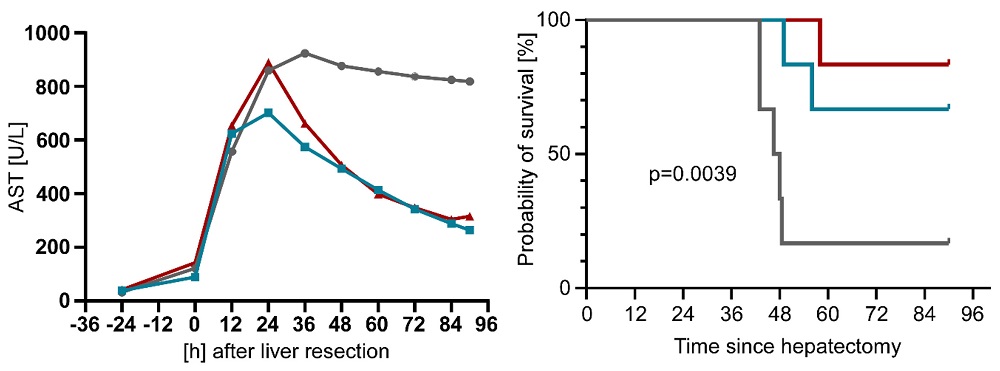In Cell, a team of researchers, including the founders of the biotech company HepaRegeniX, has published a paper on HRX215, a molecule that encourages liver regeneration.
When the liver doesn’t regenerate
The researchers note that the liver has a “nearly unlimited regenerative potential” under healthy circumstances. However, when its microenvironment changes due to damage, this potential can become lost [1]. This team has published previous work showing that MKK4, which is part of the MAPK stress response network, is a fundamental regulator of this ability and that inhibiting MKK4 encourages regeneration in liver cells [2]. No previous small molecules to inhibit MKK4 have been published, and this team claims to be the first.
Liver growth without tumors
A genetically engineered mouse model, which has its MKK4 production suppressed in the presence of doxycycline, was used as the basis for the initial experiments before the prospective drug had been produced. 72 hours after the mice’s MKK4 genes were silenced, these mice and mice in a control group had sections of their livers removed, and the mice were examined 48 hours later. The number of proliferating liver cells was considerably greater in the MKK4-silenced mice compared to the control group.
To test long-term safety, the researchers silenced MKK4 in mouse populations for 12 months. There was no evidence of toxicity, and lifespan was not significantly affected. The researchers hold that because MKK4 is part of a stress response, silencing MKK4 will make no difference in the absence of that response.
They performed a safety test by using a mouse model that is exceptionally prone to liver tumors, and then fed those mice a diet known to induce liver toxicity [3]. They then injected these mice with liver cells from either the control group or the MKK4-silenced group. There were no significant differences between the groups, although the number of liver tumors seemed to be lower in the animals that had received the MKK4-silenced cells.
Drug discovery and mouse results
Encouraged by these results, the researchers then began to conduct drug discovery. They analyzed the molecular structure of MKK4 and discovered that an existing drug that has already been clinically approved, vemurafenib, binds to it as an off-target effect. They modified this molecule, HRX215, to more strongly focus on MKK4, making sure that it does not affect related compounds that are core components of liver regeneration.
They then injected HRX215 into wild-type mice, comparing them to a control group. Similarly to the MKK4-silenced mice, these animals had no significant physical differences in the absence of liver damage. Dosing the animals with HRX215 before exposing them to carbon tetrachloride, a molecule that induces liver damage, encouraged proliferation of these cells and significantly decreased the number that had died. The protective effects were the same regardless of whether the mice received the drug at .4 mg/kg or 10 mg/kg, suggesting that a low dose is sufficient.
Giving the mice HRX215 over a long period of time showed no adverse side effects. There were no significant differences in safety-related biomarkers. Instead, it seemed to be protective in models of alcoholism and fibrosis, encouraging healthy growth while discouraging cancerous tumors. That combination is rare in drug effects, and the researchers note that some pathways that are upregulated when MKK4 is inhibited in healthy cells are downregulated instead in cancer cells.
From pigs to people
When pigs have 80% of their livers removed (resection), they normally survive. However, removing 85% of the organ usually leads to acute liver failure and death. Using a total of eight animals, the researchers tested their drug against 80% resection first, injecting them with it starting a full day before the surgery. 43 hours afterwards, the control group had regenerated 160 milliliters of liver volume, but the treatment group regenerated over 250 milliliters.
The researchers used a total of 18 animals to testing 85% liver resection: six were given HRX215 12 hours before surgery, six were given the drug 12 hours after surgery, and six were in a control group. Bilirubin and ammonia rose in the control group far more in the control group than in either of the treatment groups, which performed similarly. Intracranial pressure (ICP) rose in the control group but not in the treatment groups. AST, a marker of severe liver damage, spiked in all three groups but rapidly went down in the treatment groups. Most of the treated animals survived, but only one of the control group did.

These highly encouraging results led the researchers to perform a Phase 1 safety trial in human beings. These trials are not powered to test the drug’s efficacy; rather, they are meant to determine whether or not they lead to adverse side effects. Fortunately, there were no serious or severe side effects, and transient, mild side effects were similar between the placebo groups and the treatment groups. There were also no significant differences in blood cell counts.
The researchers hold that their results favor the development of a Phase 2 efficacy study, which would determine whether or not the drug actually helps regenerate the livers of human beings. If successful, such a drug could potentially help the lives of a great many people suffering from age-related or toxicity-related liver damage.
Literature
[1] Campana, L., Esser, H., Huch, M., & Forbes, S. (2021). Liver regeneration and inflammation: from fundamental science to clinical applications. Nature reviews Molecular cell biology, 22(9), 608-624.
[2] Wuestefeld, T., Pesic, M., Rudalska, R., Dauch, D., Longerich, T., Kang, T. W., … & Zender, L. (2013). A Direct in vivo RNAi screen identifies MKK4 as a key regulator of liver regeneration. Cell, 153(2), 389-401.
[3] Wolf, M. J., Adili, A., Piotrowitz, K., Abdullah, Z., Boege, Y., Stemmer, K., … & Heikenwalder, M. (2014). Metabolic activation of intrahepatic CD8+ T cells and NKT cells causes nonalcoholic steatohepatitis and liver cancer via cross-talk with hepatocytes. Cancer cell, 26(4), 549-564.
View the article at lifespan.io









































